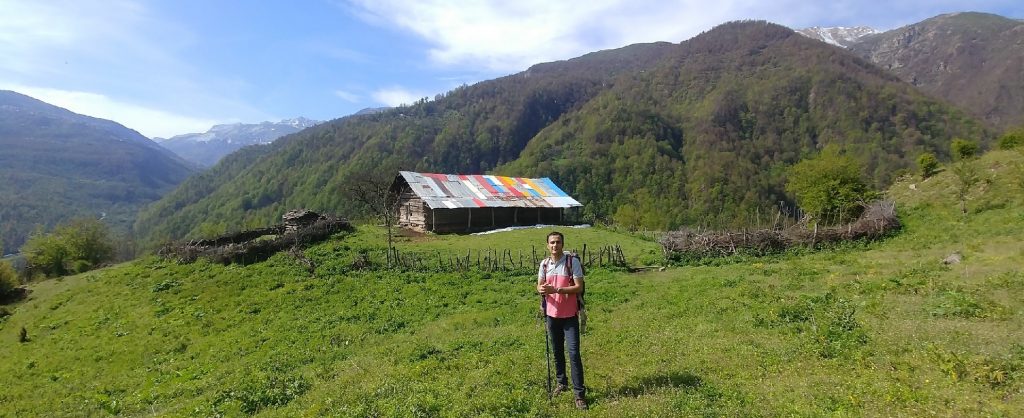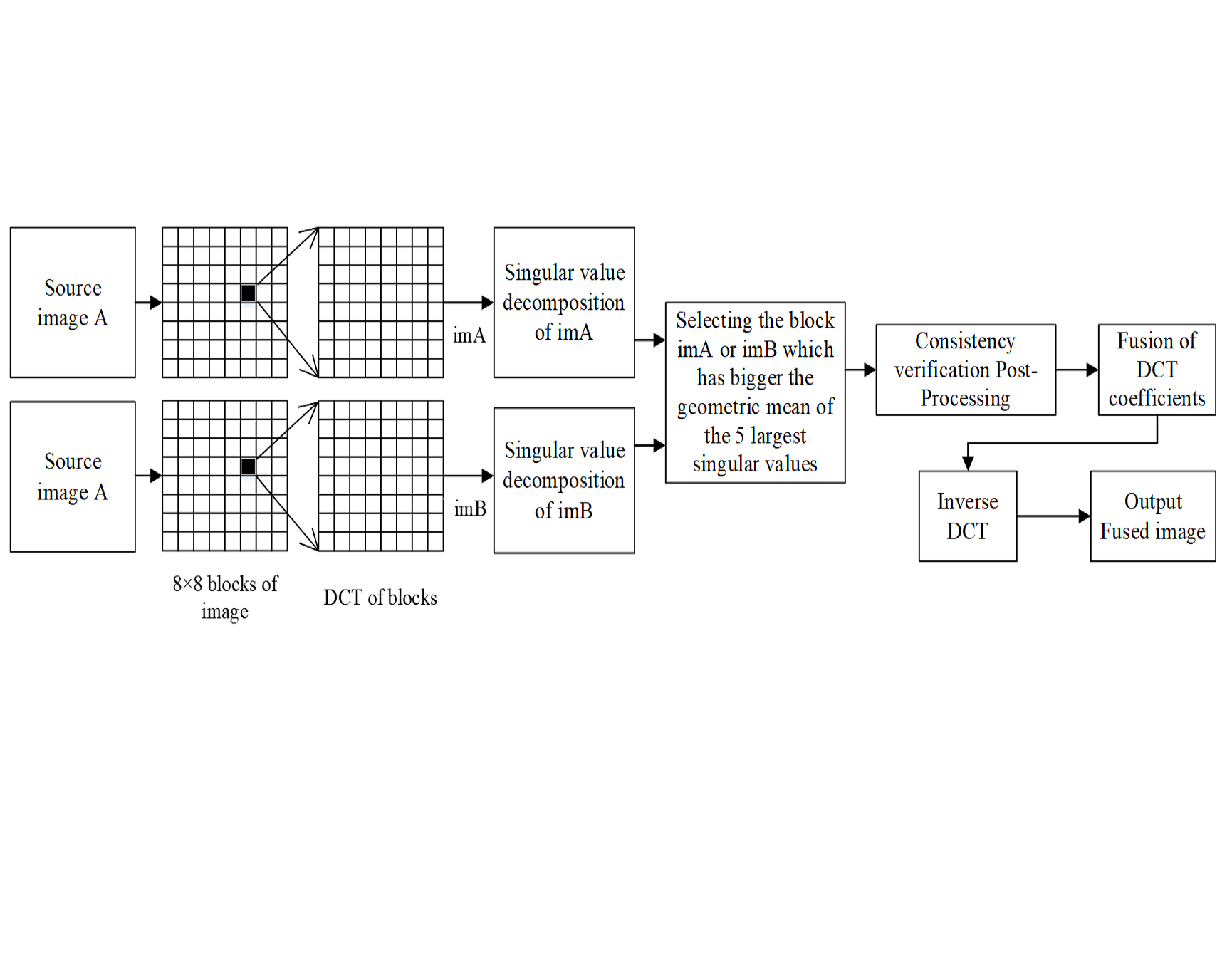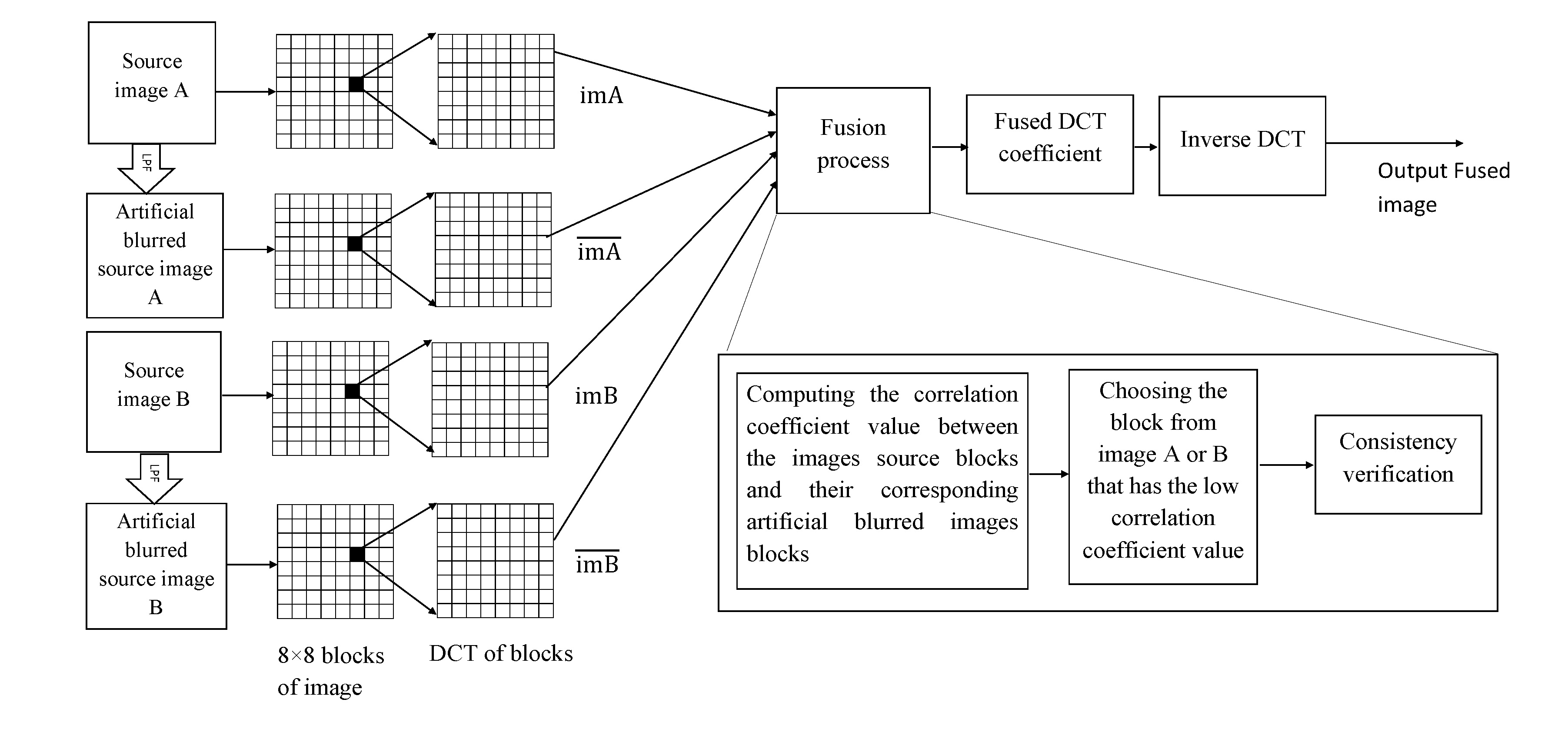Abstract: Multi-focus image fusion is a process that fuses several images from a scene with different focal lengths into a whole image in which all areas are focused on. Image fusion methods in the Discrete Cosine Transform (DCT) domain are efficient due to their low time and energy consumption, and low complexity. This is especially true when fusing images are compressed in JPEG format in Visual Sensor Networks (VSN). In this paper, a low complexity multi-focus image fusion in DCT domain is presented which increases the output image quality. Our proposed method makes it suitable for real-time applications because of its implementation in DCT domain. On the other hand, it is stable in noisy conditions. The proposed method uses the singular values of Singular Value Decomposition (SVD) of 8×8 input blocks in DCT domain. The geometric mean of the 5 largest singular values (out of 8 singular values) is computed as a criterion of focused block detection. The blocks which have the highest geometric mean value among other corresponding blocks is selected as the focused block. These blocks are then used for constructing the output image. This method can be utilized both in DCT domain and in spatial domain. Various experiments and comparisons between the proposed method and the previous methods in noisy and noiseless conditions have been presented, which confirm the increase in image quality and stability in noisy images.
(C) Mostafa Amin-Naji, Babol Noshirvani University of Technology, Mostafa.Amin.Naji@Gmail.com, PLEASE CITE THE ABOVE PAPERS IF YOU USE THIS CODE My Official Website: www.Amin-Naji.com
Multi-focus image fusion using Singular Value Decomposition in DCT domain MATLAB Code is the simulation of the following multi-focus image fusion methods in DCT domain:
(1) DCT+SVD (2) DCT+SVD+CV
proposed in:
M. Amin-Naji, P. Ranjbar-Noiey and A. Aghagolzadeh, “Multi-focus image fusion using Singular Value Decomposition in DCT domain,”, in 2017 10th Iranian Conference on Machine Vision and Image Processing (MVIP), 2017, pp. 45-51. DOI: https://doi.org/10.1109/IranianMVIP.2017.8342367
Matlab Code:
% C)Mostafa Amin-Naji, Babol Noshirvani University of Technology,
% My Official Website: www.Amin-Naji.com
% My Email: Mostafa.Amin.Naji@Gmail.com% PLEASE CITE THE BELOW PAPER IF YOU USE THIS CODE
% Mostafa Amin-Naji, Pardis Ranjbar-Noiey, Ali Aghagolzadeh, “Multi-focus
% image fusion using Singular Value Decomposition in DCT domain,” in 2017
% 10th Iranian Conference on Machine Vision and Image Processing (MVIP),
% 2017, pp. 45-51.
% DOI: https://doi.org/10.1109/IranianMVIP.2017.8342367clc
clear
close all%Select First Image
disp(‘Please Select First Image:’)
[filename, pathname]= uigetfile({‘*.jpg;*.png;*.tif’},’Select First Image’);
path=fullfile(pathname, filename);
im1=imread(path);
disp(‘Great! First Image is selected’)%Select Second Image
disp(‘Please Select Second Image:’)
[filename, pathname]= uigetfile({‘*.jpg;*.png;*.tif’},’Select Second Image’);
path=fullfile(pathname, filename);
im2=imread(path);
disp(‘Great! Second Image is selected’)if size(im1,3) == 3 % Check if the images are grayscale
im1 = rgb2gray(im1);
end
if size(im2,3) == 3
im2 = rgb2gray(im2);
endif size(im1) ~= size(im2) % Check if the input images are of the same size
error(‘Size of the source images must be the same!’)
enddisp(‘congratulations! Fusion Process in Running’)
% Get input image size
[m,n] = size(im1);
FusedDCT = zeros(m,n);
FusedDCT_CV = zeros(m,n);
Map = zeros(floor(m/8),floor(n/8));% Level shifting
im1 = double(im1)-128;
im2 = double(im2)-128;% Divide source images into 8*8 blocks and perform the fusion process
for i = 1:floor(m/8)
for j = 1:floor(n/8)im1_Block = im1(8*i-7:8*i,8*j-7:8*j);
im2_Block = im2(8*i-7:8*i,8*j-7:8*j);
% Compute the 2-D DCT of 8*8 blocks
im1_Block_DCT = dct2(im1_Block);
im2_Block_DCT = dct2(im2_Block);
sigma1=svd(im1_Block_DCT);
sigma2=svd(im2_Block_DCT);x1=sigma1(1)*sigma1(2)*sigma1(3)*sigma1(4)*sigma1(5);
x2=sigma2(1)*sigma2(2)*sigma2(3)*sigma2(4)*sigma2(5);% Fusion Process
if x1 > x2
dctBlock = im1_Block_DCT;
Map(i,j) =+1; % Consistency verification
else
dctBlock = im2_Block_DCT;
Map(i,j) = -1; % Consistency verification
end% Compute the 2-D inverse DCT of 8*8 blocks and construct fused image
% DCT+SVD Method
FusedDCT(8*i-7:8*i,8*j-7:8*j) = idct2(dctBlock);end
end% Concistency verification (CV) with Majority Filter (3×3 Averaging Filter)
Filter=fspecial(‘average’,3);
Map_Filtered = imfilter(Map, Filter,’symmetric’);
% The CV process
for i = 1:m/8
for j = 1:n/8if Map_Filtered(i,j) > 0
FusedDCT_CV(8*i-7:8*i,8*j-7:8*j) = im1(8*i-7:8*i,8*j-7:8*j);
else
FusedDCT_CV(8*i-7:8*i,8*j-7:8*j) = im2(8*i-7:8*i,8*j-7:8*j);
endend
end% Inverse level shifting
im1 = uint8(double(im1)+128);
im2 = uint8(double(im2)+128);
FusedDCT = uint8(double(FusedDCT)+128);
FusedDCT_CV = uint8(double(FusedDCT_CV)+128);% Show Images Table
subplot(2,2,1), imshow(im1), title(‘Source image 1’);
subplot(2,2,2), imshow(im2), title(‘Source image 2’);
subplot(2,2,3), imshow(FusedDCT), title(‘”DCT+SVD” fusion result’);
subplot(2,2,4), imshow(FusedDCT_CV), title(‘”DCT+SVD+CV” fusion result’);% Good Luck
% Mostafa Amin-Naji 😉





